This Page is dedicated to the Dakota C-47, Transport
Command’s Gooney Bird, Work Horse, and the crews who flew her, with no
armament, in hostile skies over enemy territory.

LIFE OF
D-DAY DAKOTA KG 395, 48 SQUADRON
Part One – Wartime service
We thank Clarence Dixon (Air Gunner’s Association #237)
for this material on a famous Dakota that still graces the skies today.
Clarence writes: I have recently received this literature
from a friend in Holland. Mr. VanHees wrote a book called Green On all
about the invasion of Arnhem. My crew was with 48 Squadron and took part
in Operation Market Garden, also took gliders and paratroops in on D-Day.
This aircraft KG395 was used on 48 Squadron and my crew
flew it many times, carrying in supplies, dropping paratroops, towing gliders
and. bringing back wounded. It still amazes me that this Dakota is still
flying.
My son has contacted Mr. Don Brooks and at present he
is installing a new motor and re-doing the cockpit. Doug Brooks, with Dak
KG395, attends airshows in the Southern States. We have contacted the people
involved with the Saskatooon Air Show to see if it would be possible to
have this Dakota and Mr. Brooks attend the Saskatoon Air show in August.
They seem to think this would be quite expensive and doubt very much if
this could be possible.
I still get news letters from the Down Ampney Assn. Where
48 Squadron was stationed.
This is a photo of our crew when we were on our first
tour at Gibrraltar.
I am the only survivor of the crew.
I put in my first tour on Hudsons and my second tour
on Dakotas.
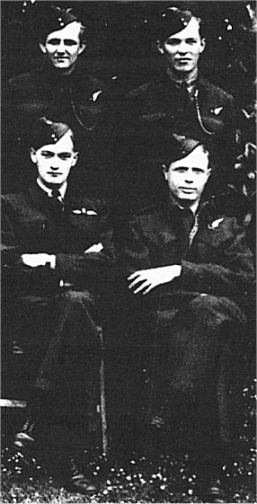
Pilot F/L Loades RAF
Nav. F/L Palin RAF
WAG F/O Dixon RCAF
WAG Sgt. Todd RCAF
Don’s D-Day
Dakota. The Saga of KG395
By Kevin S. Tanner
With today's Warbird movement, it's not uncomon for groups
or individuals to pour millions of dollars into a restoration project.
There are numerous shops around the world that specialize in such endeavours.
However there is one thing which no shop or craftsmen can produce nor money
can buy – a true combat history. This is, perhaps, one of the most sought
after characteristic of todays restoration projects. Individuals comb the
jungles, oceans and mountain sides to find relics which long ago saw combat
against the enemy.
One such aircraft exists in Douglas Georgia. This aircraft
was not removed from the depths or retrieved from a perch on some mountain
side. Instead, like the many crews who flew in her, she was able to complete
her missions and return home safely. If asked then, many of its wartime
crews would probably have laughed at the possibility that it would still
be flying 62 years later. The aircraft to which we are referring is Don
Brooks’s veteran C47 Dakota.
United States Army Air Force C-47A s/n 44-92606/N99FS
rolled off the assembly line at DouglasAircraft’s Oklahoma City factory
during January 1944. The aircraft was assigned the manufacturers construction
number 12425. After the Lend Lease act was passed in 1941, many United
States-built military aircraft were made available to Allied nations to
oppose the Axis threat. As part of this Act, this C-47 was assigned to
the Royal Air Force as a Dakota III. The British assigned the aircraft
the serial KG395 and the Dakota was flown to Dorval, in Canada, on 10th.
Of February 1944, where it was turned over to RAF Ferry Command for its
flight to the United Kingdom. On the 19th. Of February, the aircraft was
then ferried to Down Ampney, Gloucestershire, England, and was assigned
to 48 Squadron, 46 Group.
Airborne Forces Grouip 46 was formed under the Royal Air
Force Transport Command in January 1944. The Group was made up of five
Squadrons, which comprised 150 Dakotas. With the invasion of Festung Europe
fast approaching, KG395 was flown on numerous training missions towing
British Horsa gliders and dropping Airborne troops and supplies. On 3 May,
Pilot F/L F.W. Smith and his crew flew a three hour training mission to
perfect the use of the primary radio navigation system they would be using
during the Normandy invasion. Later that month the same crew flew
KG395 on a glider formation cross country exercise.
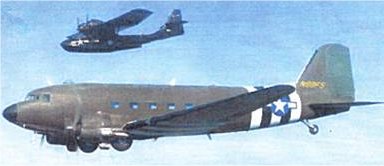
KG359 today with D-Day USAAF markings.
The “Black Cat” Catalina in the background.
D-Day
KG395 was given the Squadron code 12 and the call sign
AB (Able Baker). On 6 June, 1944, at 18:52, KG395 took off from Down Ampeny
towing a troop laden Horsa glider. The crew for this mission was F/L R.R.
Keiller, Co-Pilot W/O R.T. Berry, Navigstor F/Sgt. S.H. Birch, and
Wireless Operator W/O J.I. Perry. Escorted by Spitfires and Mustangs, the
Dakotas and their gliders made safe landfall over France near the mouth
of the Caen Canal. KG395 released its glider over the landing area at 21:04.
On the return leg back to Down Ampney, light and heavy flak was encountered
and some light damage was sustained.
On June 27, F/L Keiller and his crew flew KG395 on a standard
mission to Hurn to pick up 19 airmen. They then proceeded to advanced landing
ground B6 in France. The passengers departed and 18 stretcher patients
were loaded for the flight back to England.
On July 8, KG395 undertook another supply mission, this
time with a different crew led by F/O G.S. Taylor. Once again, the Dakota
would fly in much-needed supplies and return with stretcher patients. In
the mean time another operation was being planned.
Operation Market Garden
Operation Market Garden was conceived by General Montgomery
and was a two-phase plan which was to strike through the Low Countries.
A crossing of the Rhine River North of the Siegfried Line was to be undertaken.
Garden was the code name for the British 2nd Army’s thrust into Germany,
while Market was the code for the airborne phase of the operation. The
Airborne troops’ mission was to secure the bridges over the Willhelmina
Canal at Eindhoven, the River Maas at Grave, the Weal at Nijmegen, and
the lower Rhine at Arnhem.
On Sept. 17. KG395 took off towing a Horsa glider chalk
number 282 bound for the landing zone at Arnhem. All the gliders were cast
off and made safe landings while the tug aircraft made it back to Down
Ampney. A second glider mission was flown to Arnhem and this time KG395
was towing chalk number 813.
The second go-around for this trip would not be as smooth.
The Germans had fortified and increased their defences and heavy flak was
encountered.. Many aircraft received damage, but all made it back safely
to England.. On September 19, KG395 took off on a mission with 15 other
Dakotas to drop ammunition and supplies to the First Airbourne Division.
Two Dakotas were shot down by heavy flak. The crew for this mission were
S/L T.W. Smith, C-Pilot J.R. Hemsworth, and Wireless Operator F/Sgt. J.I.
Andersdon.
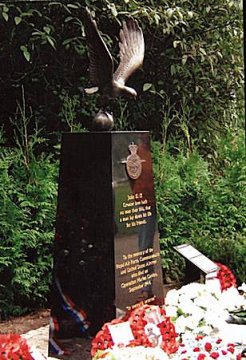
Memorial at Arnhem dedicated Summer of 2006.
To the memory of the Royal Air Force,
Commonwealth, and United States, Aircrew
who died on Operation Market Garden, September 1944.
Operation Varsity
Operation Varsity would be the largest and most successful
single airlift operation of the war in Europe. The Allies were ready to
make the final push into Germany by crossing the Rhine near Wessel. They
learned the hard lessons of Operation Market Garden and adjusted their
strategy accordingly. The Airborne Units were tasked with taking the high
ground Northeast of Wessel on the enemy’s side of the river. They also
took and held the Issel River bridges for advancing Allied forces. To be
closer to their drop zones, RAF Transport Command Squadrons and their gliders
re-positioned to airfields in East Anglia. One of these fields was Birch,
which was home for 437 Squadron. Birch was 8 miles Southwest of Colchester
and the Dakotas and Horsars, along with KG395 were flown there March 21.
On March 24, KG395 took off with 23 other Dakotas towing
Horsa gliders with 230 personnel crammed inside. In addition to their human
cargo, the gliders also carried jeeps, six-pounder guns and ammunition.
The crew for this mission was Pilot F/O J.H. Sinbad Phillips, Co-Pilot
F/Sgt. R.W. Green, Navigator F/O W.J. Hughs, and Wireless Operator, F/Sgt.
R.E. Frank. The aircraft dropped their heavily loaded gliders 20 miles
across the Rhine. KG395 received some bullet holes in the port wing, but
fortunately, no structural damage.
After this successful operation, KG395 was relegated to
a busy flying schedule hauling supplies to the front and and bringing back
the wounded. Transport also performed a somewhat humanitarian role, flying
refugees from the Belsen concentration camp in Germany to hospitals in
Belgium. KG395 then flew the Berlin Corridor in July 1945 to deliver
food from Denmark to the participants in the Potsdam Conference.
After ten days of preparation, which included the
fitting of extra fuel tanks in the fuselage for its long trip to Canada,
the Dakota departed Oldham on June 16, 1946, and headed for Goose Bay.
In June Page we will record the post-war history of
Dakota KG395 and introduce you to Don Brooks the Daks present day owner.
Stay tuned.
SHORT BURSTS
Commemorative Issue 1983 – 1993 Page 77
Transport and Army Air Support Squadrons
Murray Conrad, Wireless Air Gunner 269, 233, 437, 287
Squadrons.
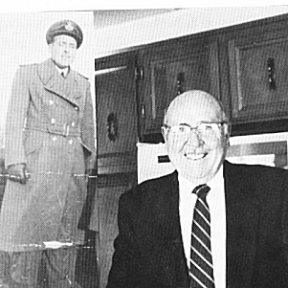 There
were many jobs involved in the Transport flying area e.g. Ferry Command,
VIP Transport, Army Air Support, Transport of Army Personnel, Transport
of wounded, ex-PoWs etc. My experience in Transport Command with 233 (RAF)
Squadron and 437 (RCAF) Squadron was in the Army Air Support role.
There
were many jobs involved in the Transport flying area e.g. Ferry Command,
VIP Transport, Army Air Support, Transport of Army Personnel, Transport
of wounded, ex-PoWs etc. My experience in Transport Command with 233 (RAF)
Squadron and 437 (RCAF) Squadron was in the Army Air Support role.
Dakota Squadrons were put together using experienced personnel
from Coastal Command Squadrons broken up in 1944 before the Second Front
invasion. They were to receive extensive training in preparation for the
invasion June 6, 1944. The heavy schedule of night and day training included
aircrew, glider personnel, especially pilots and paratroopers. Many exercises
were carried out in the months preceding the night of June 5th. All
personnel were well prepared, including WAAF nurses assigned to aircrew,
training to care for the many wounded transported from the battle areas
to the UK.
The Dakota crew consisted of a Pilot, Navigator, and WAG.
Sometimes a “Second Dickie” was carried. The WAG always acted as
the ‘dispatcher’ during the ‘drop’. His job was to see that all the troops
got out of the aircraft as fast as possible. So they would land close together.
This was not always the case – the DZ (dropping zones) were quite often
illusive! The WAG was hitched to the static line (a line running
from front to rear of the aircraft) along with all the other paratroopers.
The paratroops had a hitching line leading from the parachute to the aircraft
static line. About 26 feet from the aircraft the hitching line pulled the
parachute cover off and, hopefully, the parachute opened. And a safe landing
happened. The 20 covers attached to the lines had to be pulled back into
the aircraft by the WAG – a tough job at the best of times. I recall on
the Normandy drop I had a heck of a time bringing in the lines and the
covers. I only managed to do so with the help of the Navigator., otherwise
I would have gone overboard.
Assisting with the Paratroopers and glider pilots
was a great experience for me. I found they were the bravest of the brave.
On the night of June 5th, when we dropped our 6th Airborne, these men landed
in pitch darkness into the unknown, and they succeeded in what they had
to do – fight the enemy on the ground while we flew back to comfortable
quarters at our base in England.
Entries from my Log Book give a clearer picture.
June 5/6, 1944. -Carried 6th. Airborne Division paratroopers
who were the first to land in Normandy as an Allied invasion force. We
dropped them at 00:50 D-Day. Fuselage holed by flak. Bombs and 5 containers
dropped.
Dropped supplies to Airborne Division troops. Carried
4 army dispatchers, petrol, bedding, gun cotton, and hand grenades. Plenty
of flak in the area. Auxiliary and main tanks holed, also fuselage.
Other entries.
Sept. 17,’44 – Invasion of Holland – towed glider to
Arnhem – largest airborne ‘do’ so far
Sept. 21, ’44 – Re-supply to 1st. Airborne Division at
Arnhem – plenty of flak – attacked by Me 109 and FW 190 – escaped in cloud
cover. (Day) 5:30 hrs.
Sept. 23, ’44 – Re-supply to 1st. Airborne Division at
Arnhem. Plenty of flak – good fighter escort. (Day) 5:15 hrs.
After D-Day we were engaged in taking supplies to airfields
in France and Belgium. On return we carried wounded, mainly stretcher cases.
There were three RCAF Squadrons in the Army Air Support
role, 435, 436, and 437. Both 435 and 436 operated in Burma (my brother
was a pilot (F/L) on 436. As far as I know only 437 was on operations in
the UK. W/C Sproule was the first CO of 437 Squadron.
It is appropriate that we re-publish the following pictures
from the late Allan Coggon’s book
FROM WINGS PARADE TO MANDALAY
(see book review February 2006 http://www.airmuseum.ca/mag/0602.html
),
showing the Dakota crews carrying out Army support duties,
in this case over the Jungles of Burma.
Don Macfie
When the war ended most of our crew seemed to be in a
terrible rush to get back home, get married, and see dear old Mom. Me?
I thought I could do with some more adventure (even after two tours hunting
subs), signed up for the interim air force, and stayed overseas.
Eventually I was crewed up with a pilot on 435 Squadron
flying Dakotas, flipping around Europe from Oslo to Naples, and up to our
ears in the black market, cigarettes, coffee beans, and white bread. On
a trip to Buckeburg in Germany, BAFO HQ, we were billeted in the Kaiser’s
Palace, and were told that a good place for cigarette sales was in a town
called Minden, about 15 miles away. There one could get two marks for a
cigarette.
Hitchhiking was no problem and we were soon there, each
with a carton. Contact was soon made, a woman who said we were to follow
her. We came to a boarded up ground floor room of what was left of a bombed
out house. There were two other middle-aged ladies there, and a boy of
about 15 years studying in a corner at a school desk lit by a small candle.
The transaction was handled smoothly and, with pockets
laden with marks, we turned to leave. My Pilot waved a gesture of good-bye,
whereupon the ladies, standing in a row, clicked their heels and gave us
the Nazi salute. As we were walking towards the edge of town, my Pilot
started walking faster, and said, “come on Red, lets get out of here.”
An American Jeep picked us up and we were soon back in Buckeburg.
When settled down I asked him what all the rush was about
back in Minden. His explanation was as follows. He had done ops. as a Mosquito
bomber Pilot and one night he could not locate the target. Returning home
with bombs on board, he saw a town through a break in the cloud and dumped
his load across it. He said, “I did that, wrecked all those houses. The
mess we saw back there on both sides of the street, and what I had done
to those people, I couldn’t take it. I had to get out of there!”
A short time later we were over night in Prague and we
were held up by weather. My Pilot got too well acquainted with one of the
female Chec. Students who were part of our passenger load back to the UK.
To make matters more complicated we took off with a fine looking police
dog in the a/c lavatory.
Over Croydon airfield we were stacked up in the seventh
level but eventually got down to level four in high turbulence. We continued
to orbit waiting to land. The Pilot asked me to go back and see how the
young ladies were taking it. When I went back they all jumped up into the
isle and started chattering in a language I could not understand. Right
then my old bugaboo, airsickness, hit me. I reached for a sick bag over
a window where they were stowed, and let go. The ladies all did the same.
We all up-heaved the nice lunches we had been given in Prague.
We landed rather late at Croydon. No runway lighting.
At the end of the runway, the dog was spirited away, but something happened
to the scheme, I never heard what. In a very short time, the Pilot was
riding the bounding main back to Canada, whether he wanted to get married,
see his old Mom, or not.
I never did find out if dogs got airsick. From then on
I flew with Pilots who had been instructors.
From: Halifax 57 Rescue (Canada)
To: John Moyles
Sent: Sunday, April 22, 2007 10:53 AM
Subject: New Progress Report 18
Dear John, Please note that the newest and most
important Progress Report 18 is out on our website. http://www.57rescuecanada.com/ProgressReports/PReport18.htm
if we get the funding we need now we may be able to find
LW170 this year !!
Hope to hear from you soon. Cheers, Karl
HALIFAX
57 RESCUE (CANADA)
Progress Report No.18 (In Part)
April 7, 2007
Registered Charity 84586 5740 RR0001
As Halifax 57 Rescue (Canada) starts into our third full
season I look back and think of our journey together in our quest to find
and recover RCAF Halifax LW170. We are closer than you think to a major
breakthrough and so we must press on with renewed determination towards
our ultimate goal. We are at a vital juncture in the Halifax Project and
we need your support more than ever before, in these next few weeks.
ON TO BUSINESS, THESE ARE THE HALI-FACTS
In our last progress report I told you of the exciting
news that the Irish national television network – RTE invited myself
to Dublin to tell about the Halifax Project on their variety show “Seoige
and O’Shea” on Feb.22. I traveled over to Dublin by air on Feb. 22 (after
working my Air Canada flight all night from Toronto!) and was on the air
just after 4 pm.
The interview was short at only 10 minutes but it was
broadcast live all across Ireland. I was able to tell all about out past
recoveries of Halifaxes NA337 and LW682 with historic video of NA337 images
as colourful background to our interview. I then told them of our revelation
of the 11 Irish Nationals killed-in-action on RCAF Halifaxes along with
our proposed Halifax Project details including a dedication to the unknown
“RCAF Irish”. To date we have had over 2000 hits from Ireland on our website
because of the TV program. In fact we now have a Mr. and Mrs. Lacey
in Dublin researching to find the families of these RCAF Irish for us and
the nephew of Sgt. Dinnen, killed-in-action on a RCAF Halifax, has
been in touch with us with information about his uncle.
Later on I was given a DVD copy of this television interview
which we hope to share with our members soon, subject to the permission
of RTE and Jim Blondeau to set up a website location to see the interview
on the internet. RTE definitely wants to follow up with us on the Halifax
Project and possibly cover the location and recovery events of the Halifax
Project in the near future.
Further to this, I was able to meet with the deep sea
exploration group to give a technical briefing on the proposed Phase 1
– Sonar survey of RCAF Halifax LW170 and discuss the possibility of this
group helping us locate our Halifax. We talked about the feasibility of
attaching the Halifax sonar survey, as a historical effort, onto a scientific
survey. There are several scientific surveys done in the deep water near
LW170 each year so we must find out which surveys are being planned and
hopefully we can “piggyback” our historic survey on to one of these scientific
expeditions.
With the positive reception by this scientific group to
our request for sonar survey assistance to find LW170 we have rallied all
our high level Canadian officials to provide letters of support and reference
for the Halifax Project which will be going to this scientific group and
influential officials who can assist us. If we can get high level approval
for the Halifax Project with these people, just as our Canadian officials
have supported us, then I think we will be able to get the Halifax sonar
survey done without major costings. By this I mean we could save (60 to
90%) of the sonar surveys costs which I have estimated to complete would
be ($ 265, 000.).
I apologize for withholding names and groups but until
we have an agreement in principle and fact, which will be forthcoming in
the next few weeks, I do not want to announce any premature agreements
or partnerships for the Halifax Project until all is in place. There are
several reasons for this but the priority is to make the Halifax Project
a success.
To this end, I must now speak frankly to all of you about
the financial situation of Halifax 57 Rescue (Canada). Thanks to our individual
members and the sales of the Halifax prints, Halifax CD-ROMS, memberships
renewals, and donations we are doing OK from month to month. You have seen
over the past 36 months the good work we have done (on a very tight budget)
to promote and build up the Halifax Project. I was hoping to find a major
sponsorship with the government or corporate world for the Halifax Project
to sponsor all or part of the cost of Phase 1 of the Halifax Project. We
have found no major sponsor to date but we will keep trying. If we
can get the critical sonar image of Halifax LW170, just as we got the sonar
image of NA337 in 1995, we can sell our project to all the possible major
supporters who right now are “sitting on the fence”. That sonar image of
LW170 is the key.
Here we have a golden opportunity to work with a top-line
deep water exploration group which could sponsor and underwrite our Phase
1 to acquire the image of LW170 using their high tech research vessel.
This group has indicated to me that the deep water sonar they use is a
lease-rental and they would like Halifax 57 Rescue (Canada) to pay for
the costs of this high tech sonar on their vessel. This would mean that
we would need to be ready to pay, in the next several weeks, in the order
of ($ 25,000 to $30,000) for our share of a sonar survey. Considering that
the cost of the vessel is the main cost of the sonar survey we are getting
this opportunity for about (90%) off the entire sonar survey expedition
cost.
We have the timely and serious need to now have members
and supporters send in their donations and purchase orders to show, to
our future sponsors and those “sitting on the fence” we are serious about
going ahead with the Halifax Project - Phase 1. If we only had 30 people
step up now to donate ($ 1000.) each we would finally be ready to move
into Phase 1 and be ready for our survey.
A command decision is in order and I have decided to be
the first in this critical funding drive. I have just written a personal
cheque to Halifax 57 Rescue (Canada) for $1000. I am not as concerned,
as a director and Project Manager, about the tax receipt which will certainly
be a benefit to you for the tax year 2007, but mainly about showing my
serious intent to get our historic project started at this opportune time.
Please send in soon whatever you can afford so we will be ready to go this
summer! Our aim is to make the $30,000. target. I cannot stress how
important these funds are at this time to make the Halifax Project GO !!
In other news about gaining support for our project Ken
Cothliff of Air Supply Aviation Store in Leeds, UK (whose father was a
pilot in RCAF 425 Squadron and killed-in-action) made some great arrangements
for us and set up a lecture date of Mar.23 at a local hall to give a presentation
on the Halifax Projects of NA337 and LW170. Over 60 people attended the
lecture by yours truly which was enjoyed by all.
Ken has been selling INVINCIBLE ITEM for us at his shop
and when the evening was drawing to a close he presented a cheque to us
for over $1500. for print sales and proceeds from the lecture. We greatly
appreciate all of Ken’s efforts on our behalf and thanks to him and his
good wife Doreen for putting up with me for a day in Leeds. We truly have
some good friends in Leeds and Yorkshire. ( see below the cheque presentation
photo by Ken to yours truly).
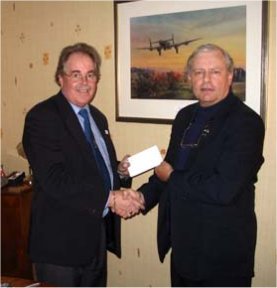
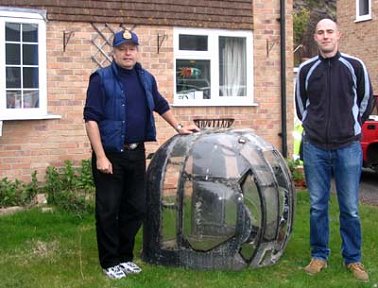 I should add that while over in the UK on this lecture date
I was able to travel out to Bristol in a van to pick up an original Halifax
Boulton Paul tail turret for the Nanton Lancaster Society Air Museum. Thanks
to museum curator Bob Evans, who had been contacted by Stephen Watts the
owner of the Halifax tail turret, I was able to pick up this rare turret
and get it shipped to Canada by good old Air Canada cargo. Seeing
as how Nanton has one of the best turret collections in all of Canada and
they collecting all the Halifax artefacts they can, this certainly will
be a rare and unusual addition to their collection.
I should add that while over in the UK on this lecture date
I was able to travel out to Bristol in a van to pick up an original Halifax
Boulton Paul tail turret for the Nanton Lancaster Society Air Museum. Thanks
to museum curator Bob Evans, who had been contacted by Stephen Watts the
owner of the Halifax tail turret, I was able to pick up this rare turret
and get it shipped to Canada by good old Air Canada cargo. Seeing
as how Nanton has one of the best turret collections in all of Canada and
they collecting all the Halifax artefacts they can, this certainly will
be a rare and unusual addition to their collection.

As you know prominent authors have written some very good
books about the RCAF and Bomber Command which they have kindly offered
to display and offer for sale here to help our cause. We have the unique
“Bless you Brother Irvin” by John Neal which we have had available for
some time where proceeds from the sale of the book about air force bailouts,
the Caterpillar Club, will be donated to our cause.
We also have “Flying to Glory”, by Sandra Dempsey the
playwright, which has had very good reviews as a fine story all about young
airmen in the RCAF and Bomber Command. We hope to hear from Sandra soon
as she was giving a unique reading of her book to audiences in New York
at a special event. She was also going to tell of the unknown story of
our RCAF Americans as over 120 young crew from the state of New York were
killed-in-action in the RCAF.
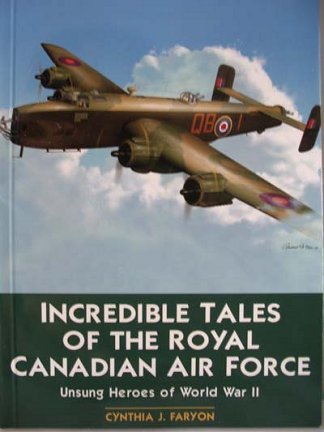 Now
we have a new addition to our reading selection we wish to promote and
pass on to you.
Now
we have a new addition to our reading selection we wish to promote and
pass on to you.
This book is titled “Incredible Tales of the Royal Canadian
Air Force” by Cynthia J. Faryon. Not only are these stories about
the unsung heroes of World War Two but they also include an epilogue about
the recovery of RCAF Halifax LW682 in 1997 and the promotion of our Halifax
Project to recover LW170.
Also, Cynthia has used, with our blessing, the great image
of our INVINCIBLE ITEM on the cover of her book.
Published by Altitude Publishing this book is one of the
great series named Amazing Stories which are all about Canadian history.
Cynthia’s father was her personal hero as he was a decorated RCAF veteran
in Bomber Command. Well done Cynthia for another great book.
(See photo of the front cover of this new book available
for only $ 9.95 Can. )
As Project Manager of these historical projects I am starting
to have a feeling about when we should move forward and when we should
press hard in our goals and targets.
I truly feel that now is the time to press forward and
take the initiative on this most special project to save our Halifax.
Certainly we are in this for the long run and we will
not be denied our heritage and history as we locate and recover LW170 even
if it is next year or the next. I have always listened to that little voice
inside me that I have developed over the years from living and from flying.
That voice tells me that we must move now and take the first big and serious
step to find our Halifax. The high-tech assistance and partnership which
is being offered to us should be developed and solidified. I say this as
your advisor and Project Manager hoping that you will understand
the sincerity and strength of this timely financial appeal.
Halifax 57 Rescue (Canada) hopes to receive from all of
you soon your support in whatever amount you can provide.
Keep your eyes on the target.
Sincerely,
Karl Kjarsgaard
Project Manager
Halifax 57 Rescue (Canada)
www.57rescuecanada.com
Phone - Eastern Canada 613 835 1748
email: 57rescuecanada@rogers.com
Western Canada 403 603 8592
WE GET
LETTERS
E. J. Chenier CD
Hello everyone!
The following is an e-mail that I sent to my member of
parliament as well as to the Ottawa War Museum.
After you've read it, if you decide that you agree with
me, forward it to your member of parliament and also to the War Museum
at info@warmuseum.ca
If you don't agree with me, well, just delete it.
Ed
To: Mr. Rod Bruinooge
Member of Parliament, Winnipeg South
Board of Directors, Ottawa War Museum
Dear Sirs;
As an officer who flew on bombing missions over Germany
during WW2, I am insulted and outraged at the wording on a plaque at the
Ottawa War Museum, which insinuates that we, both Canadians and Americans
who
participated, are war criminals.
Recently, the President of the United States along with
Members of Congress and of the Senate gathered together to Honour a Fighter
Squadron, composed of strictly Black personnel, who had flown as protective
escort for the American Air Force on bombing missions over Germany
during WW2. They hailed them as heroes and gave them a "Standing Ovation".
This is how Americans, treat their Veterans.
Ironically, our Canadian Government is standing by, allowing
the Ottawa War Museum to erect a plaque that insinuates that these American
veterans, and we Canadian veterans who flew on bombing missions over Germany
during WW2 are "War Criminals".
ONLY IN CANADA . . . PITY
E. J. Chenier CD
Flight Lieutenant (Ret'd)
208-815 St. Anne's Rd
Winnipeg, MB R2N 3X6
deed2ed@shaw.ca
Dear Sir,
Finally, a committee has been formed in the Senate to
investigate the controversy of the Ottawa War Museum plaque that insinuates
that Air Force veterans, like myself, who flew on bombing missions over
Germany during WW2, are "War Criminals". Good luck to these Senators and
hopefully they will convince the "Expert Historians" on the board of the
museum, that their statement is in fact not a balanced one, and should
be removed.
E. J. Chenier CD
Editor. In the evening of April 21st. I was
channel jumping on the TV and accidentally landed on a documentary of the
Senate Committee for the Department of Veteran’s Affairs hearing presentations
regarding the Plaque. It lasted for approximately 30 minutes.
Mr. Donald Elliot, ex-Navigator, now a retired lawyer,
made a presentation on behalf of the Air Force Association. At 90 years
of age he was excellent, and emphatically answered all questions put to
him by the Committee. There was no representative from the War Museum.
My question – to whom does the Senate Committee report?
Charley Yule
Thought I should keep you up to date on my anticipated
trip to Nanton, AB on August 26th to attend the Annual 'Get-together'.
I have ordered 6 tickets for my party and have been assured
that, when they are printed, I will be receiving that number.
I am hoping that those of us (Particularly those
who have an "Air Gunner" and "Handley Page Halifax connection") who may
be planning to attend this function might be able to be seated together
with other of 'our kind' - or at least at adjoining tables.
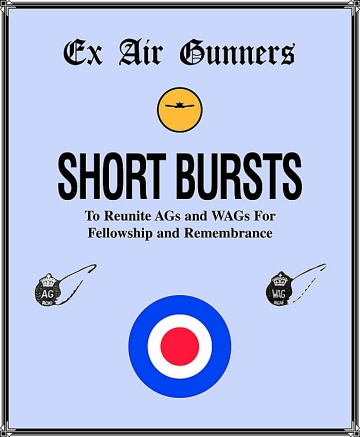

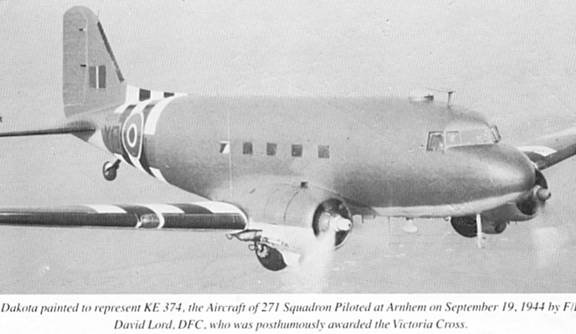
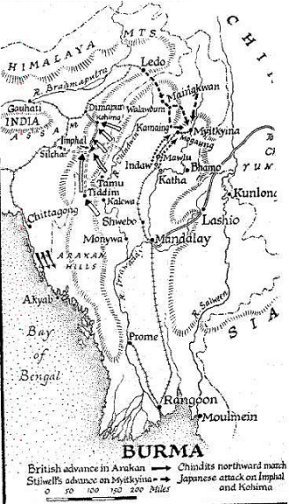
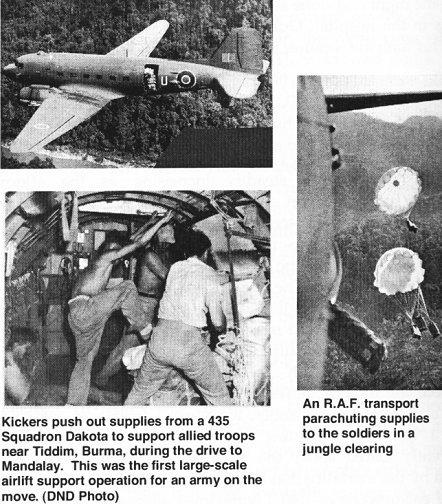
![]()
![]()
![]()
![]()